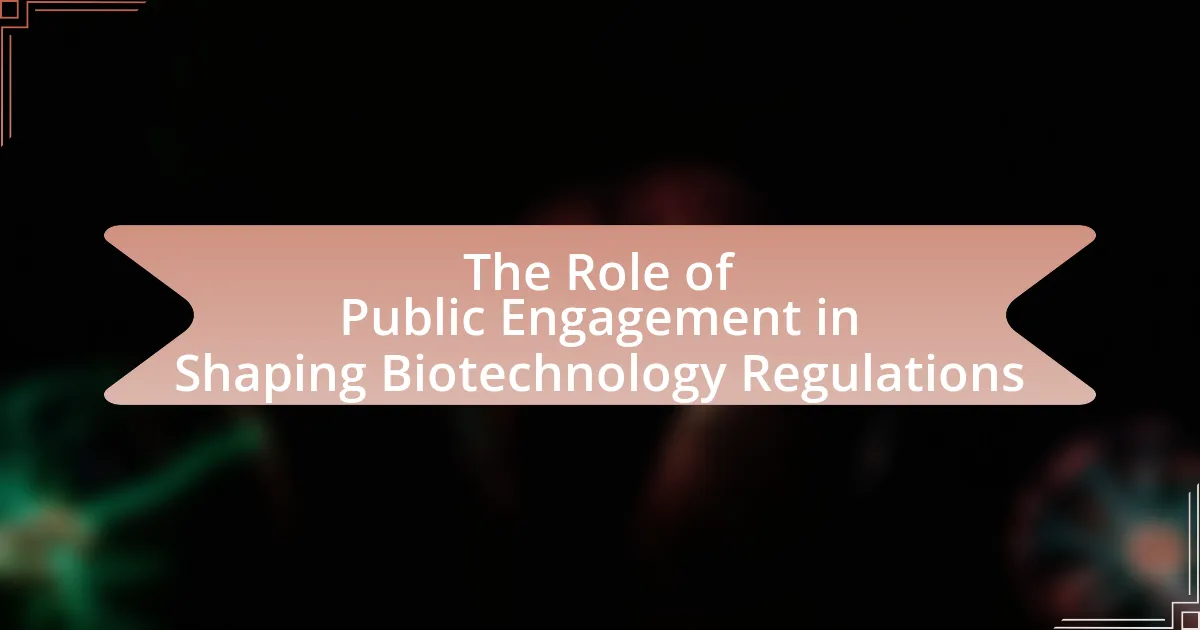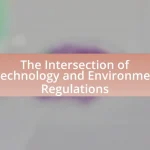Public engagement is a vital component in shaping biotechnology regulations, as it ensures that diverse stakeholder perspectives are integrated into the regulatory process. This article examines the importance of public engagement in fostering transparency, building trust, and enhancing the legitimacy of biotechnology policies. It discusses various methods of engagement, such as public consultations and social media, and highlights the influence of public input on regulatory outcomes. Additionally, the article addresses challenges faced in public engagement, including misinformation and representation disparities, while outlining best practices for effective participation in biotechnology discussions.
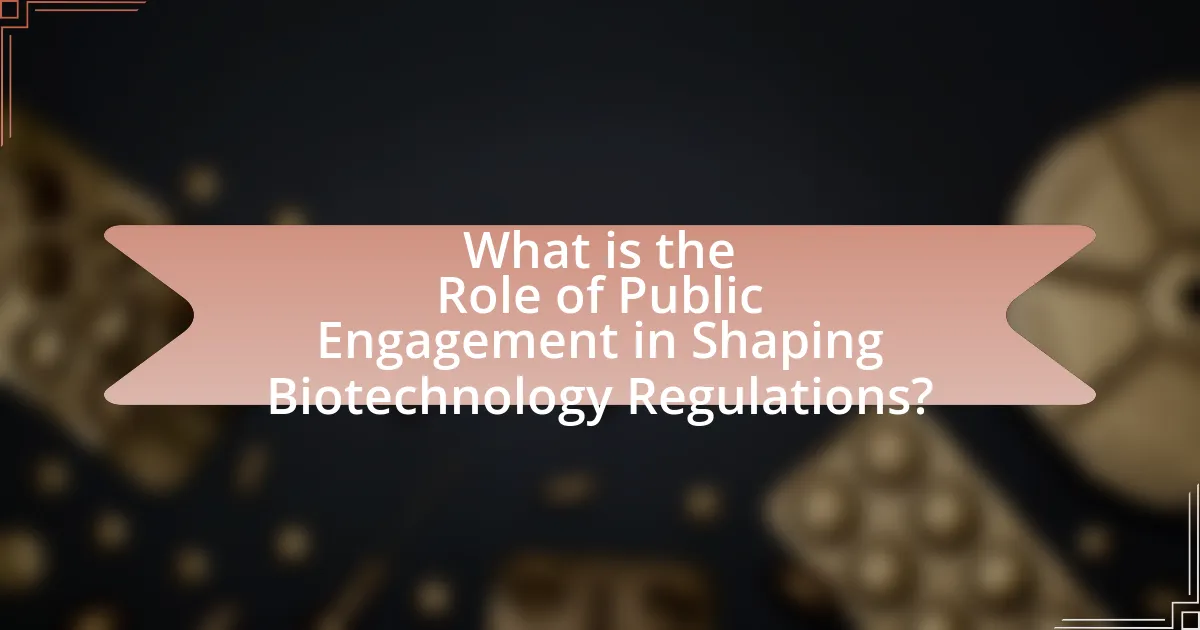
What is the Role of Public Engagement in Shaping Biotechnology Regulations?
Public engagement plays a crucial role in shaping biotechnology regulations by ensuring that diverse stakeholder perspectives are considered in the regulatory process. This engagement fosters transparency and trust, allowing the public to voice concerns and preferences regarding biotechnological advancements. For instance, public consultations and forums have been utilized by regulatory bodies like the U.S. Food and Drug Administration (FDA) to gather input on genetically modified organisms (GMOs), which has influenced policy decisions and guidelines. Research indicates that inclusive public dialogue can lead to more informed and accepted regulations, as seen in the European Union’s approach to biotechnology, where public opinion significantly impacts regulatory frameworks.
Why is public engagement important in biotechnology regulation?
Public engagement is important in biotechnology regulation because it fosters transparency, builds trust, and ensures that diverse perspectives are considered in decision-making processes. Engaging the public allows regulatory bodies to understand societal concerns and values, which can lead to more informed and acceptable regulations. For instance, studies have shown that public input can enhance the legitimacy of regulatory frameworks, as seen in the European Union’s approach to genetically modified organisms, where public consultations have shaped policies to reflect community values and concerns. This participatory approach not only improves the quality of regulations but also promotes public acceptance and understanding of biotechnological advancements.
What are the key benefits of involving the public in biotechnology discussions?
Involving the public in biotechnology discussions enhances transparency, fosters trust, and encourages informed decision-making. Public engagement allows diverse perspectives to be considered, which can lead to more comprehensive and socially acceptable biotechnology policies. For instance, studies have shown that when the public is involved, there is a greater likelihood of addressing ethical concerns and societal impacts, ultimately resulting in regulations that reflect community values and priorities. This participatory approach can also improve the legitimacy of biotechnological advancements, as seen in initiatives like the UK’s public dialogue on genetically modified organisms, which demonstrated increased public understanding and acceptance of biotechnology when stakeholders were actively engaged.
How does public engagement influence regulatory outcomes?
Public engagement significantly influences regulatory outcomes by providing stakeholders with a platform to express their concerns, preferences, and insights, which regulators can incorporate into decision-making processes. For instance, when the U.S. Environmental Protection Agency (EPA) conducted public consultations on the regulation of genetically modified organisms, feedback from farmers, consumers, and environmental groups led to more comprehensive assessments of ecological impacts. This interaction not only enhances transparency but also fosters trust in regulatory bodies, as evidenced by studies showing that inclusive regulatory processes can lead to more effective and accepted policies.
What are the main methods of public engagement in biotechnology?
The main methods of public engagement in biotechnology include public consultations, stakeholder meetings, educational outreach, and participatory research initiatives. Public consultations allow citizens to express their views on biotechnology policies, while stakeholder meetings facilitate dialogue among industry, government, and community representatives. Educational outreach programs aim to inform the public about biotechnological advancements and their implications, and participatory research initiatives involve the public in the research process, enhancing transparency and trust. These methods are essential for fostering informed public discourse and shaping effective biotechnology regulations.
How do public consultations work in the context of biotechnology regulations?
Public consultations in the context of biotechnology regulations involve structured processes where stakeholders, including the public, industry representatives, and experts, provide input on proposed regulations or policies. These consultations typically occur during specific phases of regulatory development, allowing for feedback that can influence decision-making.
Regulatory agencies often announce public consultations through various channels, such as official websites or public notices, detailing the scope of the consultation, timelines, and methods for participation. Stakeholders can submit comments, attend public meetings, or participate in workshops to express their views and concerns.
The effectiveness of public consultations is supported by evidence showing that inclusive engagement leads to more informed and balanced regulatory outcomes. For instance, the U.S. Environmental Protection Agency (EPA) has documented cases where public input has shaped environmental regulations, demonstrating the value of stakeholder perspectives in regulatory processes.
What role do social media and online platforms play in public engagement?
Social media and online platforms serve as critical tools for public engagement by facilitating communication and interaction between stakeholders, including the public, policymakers, and experts in biotechnology. These platforms enable the dissemination of information, allowing diverse voices to contribute to discussions on biotechnology regulations. For instance, a study by the Pew Research Center found that 69% of adults in the U.S. use social media, which amplifies public awareness and participation in regulatory debates. Additionally, social media campaigns can mobilize grassroots movements, influencing policy decisions and fostering transparency in the regulatory process.
What challenges exist in public engagement for biotechnology regulations?
Public engagement in biotechnology regulations faces several challenges, including a lack of understanding among the general public about complex scientific concepts. This complexity often leads to misinformation and fear, which can skew public perception and hinder constructive dialogue. Additionally, there is often a disparity in the representation of diverse community voices, resulting in regulatory frameworks that may not reflect the values and concerns of all stakeholders. Research indicates that effective public engagement requires not only clear communication but also the establishment of trust between regulatory bodies and the public, which can be difficult to achieve in a climate of skepticism towards science and technology.
How can misinformation affect public perception and engagement?
Misinformation can significantly distort public perception and engagement by creating false narratives that influence opinions and behaviors. For instance, studies have shown that misinformation regarding biotechnology, such as genetically modified organisms (GMOs), can lead to increased public fear and resistance to scientific advancements. A survey conducted by the Pew Research Center found that 88% of Americans believe that misinformation about science is a major problem, which directly correlates with decreased trust in scientific institutions and reduced public participation in discussions about biotechnology regulations. This decline in trust can hinder effective engagement, as individuals may become less likely to participate in dialogues or support policies based on inaccurate information.
What barriers do regulatory bodies face in facilitating public engagement?
Regulatory bodies face several barriers in facilitating public engagement, primarily including a lack of resources, insufficient public understanding of complex regulatory processes, and challenges in effectively communicating scientific information. Limited funding and staffing can hinder outreach efforts, making it difficult to engage diverse community members. Additionally, the technical nature of biotechnology regulations often leads to public confusion, which can result in disengagement. Effective communication strategies are essential, yet many regulatory bodies struggle to present information in an accessible manner, further complicating public involvement.
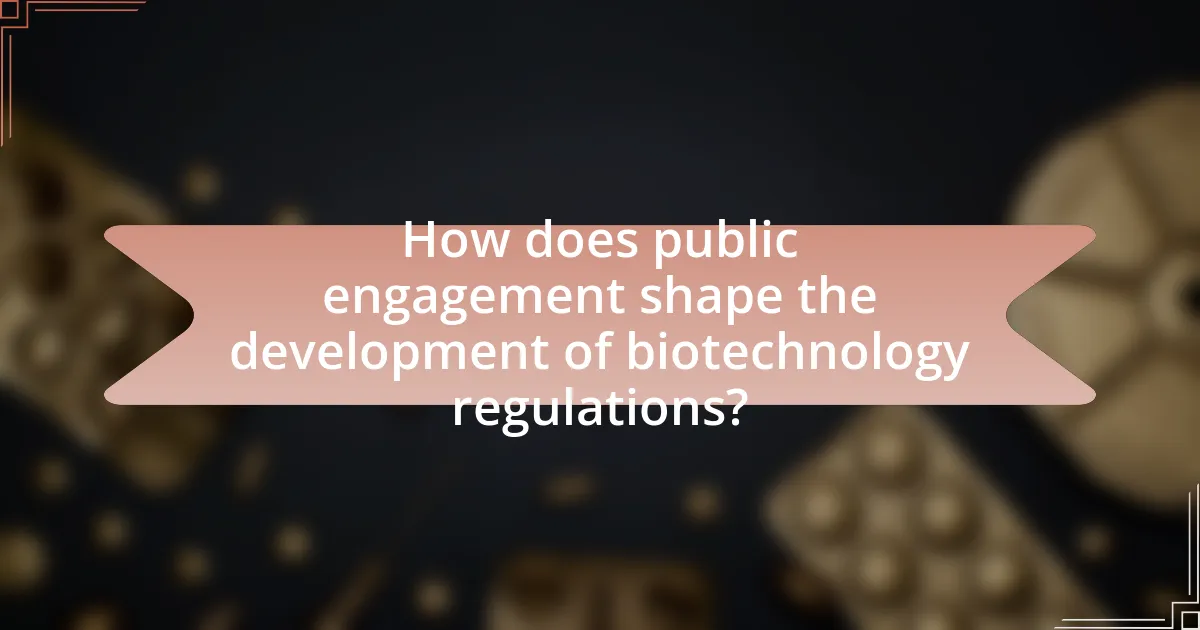
How does public engagement shape the development of biotechnology regulations?
Public engagement significantly shapes the development of biotechnology regulations by incorporating diverse perspectives and addressing societal concerns. This engagement fosters transparency and trust between regulatory bodies and the public, leading to more informed decision-making. For instance, public consultations and stakeholder meetings allow citizens to voice their opinions, which can influence regulatory frameworks to better reflect public values and ethical considerations. Research indicates that when the public is actively involved, regulations tend to be more robust and accepted, as seen in the European Union’s approach to genetically modified organisms, where public sentiment has led to stricter regulations.
What processes are influenced by public input in biotechnology regulation development?
Public input influences several key processes in biotechnology regulation development, including risk assessment, policy formulation, and stakeholder engagement. During risk assessment, public feedback can shape the evaluation of potential hazards associated with biotechnological products, ensuring that community concerns are addressed. In policy formulation, public input helps to create regulations that reflect societal values and ethical considerations, as seen in the development of guidelines for genetically modified organisms. Additionally, stakeholder engagement processes benefit from public input by fostering transparency and trust, which are essential for effective regulatory frameworks. These processes demonstrate the importance of incorporating diverse perspectives to enhance the legitimacy and effectiveness of biotechnology regulations.
How do stakeholder opinions impact regulatory frameworks?
Stakeholder opinions significantly influence regulatory frameworks by shaping the policies and guidelines that govern biotechnology. Regulatory bodies often consider the perspectives of various stakeholders, including industry representatives, advocacy groups, and the public, to ensure that regulations reflect societal values and address concerns. For instance, public consultations and stakeholder meetings are common practices that allow regulators to gather input, which can lead to adjustments in proposed regulations based on feedback. This process is evident in the development of the European Union’s General Data Protection Regulation (GDPR), where extensive stakeholder engagement helped refine the final text to balance innovation with privacy concerns. Thus, stakeholder opinions are integral to creating responsive and effective regulatory frameworks in biotechnology.
What examples exist of regulations changed due to public engagement?
Regulations have been changed due to public engagement in several notable instances. One example is the U.S. Environmental Protection Agency’s (EPA) decision to revise its regulations on genetically modified organisms (GMOs) following public outcry and advocacy for stricter oversight. In 2015, the EPA proposed new rules that required more comprehensive assessments of the environmental impacts of GMO crops, reflecting the concerns raised by citizens and environmental groups. Another example is the European Union’s regulation on the labeling of GMOs, which was influenced by public demand for transparency and consumer choice, leading to the implementation of stricter labeling requirements in 2018. These changes illustrate how public engagement can effectively shape regulatory frameworks in biotechnology.
How do different countries approach public engagement in biotechnology regulations?
Different countries approach public engagement in biotechnology regulations through varying mechanisms, reflecting their unique cultural, political, and social contexts. For instance, in the United States, public engagement often occurs through public comment periods and stakeholder meetings, allowing citizens to voice their opinions during the regulatory process. In contrast, the European Union emphasizes transparency and public consultation, mandating that member states involve citizens in discussions about biotechnology policies, as seen in the EU’s Directive on the Deliberate Release of Genetically Modified Organisms. Additionally, countries like Canada utilize multi-stakeholder dialogues that include industry, academia, and civil society to foster a collaborative approach to biotechnology regulation. These diverse strategies highlight the importance of public involvement in shaping biotechnology regulations, ensuring that policies reflect societal values and concerns.
What are the best practices from countries with successful public engagement strategies?
Countries with successful public engagement strategies prioritize transparency, inclusivity, and ongoing dialogue. For instance, in Sweden, the government actively involves citizens in decision-making processes through public consultations and forums, ensuring diverse perspectives are considered. Similarly, New Zealand employs a co-design approach, engaging stakeholders from the outset of policy development, which fosters trust and collaboration. Research indicates that these practices lead to higher public trust and acceptance of biotechnology regulations, as seen in the European Union’s emphasis on stakeholder engagement in regulatory frameworks. These strategies demonstrate that effective public engagement can significantly influence the shaping of biotechnology regulations.
How do cultural differences affect public engagement in biotechnology?
Cultural differences significantly affect public engagement in biotechnology by influencing perceptions, attitudes, and trust levels toward biotechnological advancements. For instance, in collectivist cultures, community consensus and traditional values may lead to heightened skepticism about biotechnology, particularly regarding genetic modification, as seen in countries like Japan where public opinion often prioritizes safety and environmental concerns. Conversely, individualistic cultures, such as the United States, may exhibit more openness to biotechnological innovations, driven by a focus on personal choice and innovation. Research by the Pew Research Center indicates that cultural context shapes how individuals interpret scientific information, with varying levels of acceptance and engagement based on cultural norms and values. This demonstrates that understanding cultural differences is crucial for effective public engagement strategies in biotechnology.
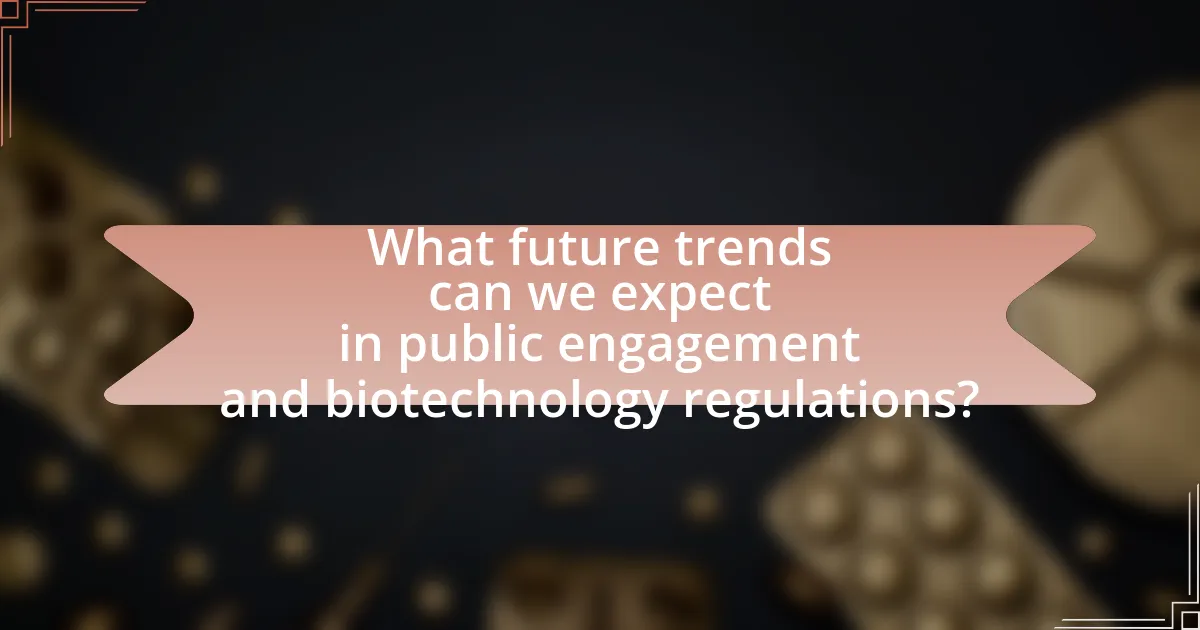
What future trends can we expect in public engagement and biotechnology regulations?
Future trends in public engagement and biotechnology regulations will likely include increased transparency, enhanced stakeholder participation, and the integration of digital platforms for communication. Regulatory bodies are recognizing the importance of involving the public in decision-making processes, as evidenced by initiatives like the U.S. Food and Drug Administration’s (FDA) Patient Engagement Advisory Committee, which aims to incorporate patient perspectives into regulatory frameworks. Additionally, the rise of social media and online forums is facilitating broader discussions and feedback mechanisms, allowing for real-time public input on biotechnological advancements. This shift towards more inclusive engagement is supported by studies indicating that public involvement can lead to more informed and accepted regulatory outcomes, ultimately fostering trust in biotechnology innovations.
How might technology enhance public engagement in biotechnology?
Technology enhances public engagement in biotechnology by facilitating access to information and enabling interactive communication. Digital platforms, such as social media and dedicated websites, allow stakeholders to share knowledge, ask questions, and participate in discussions about biotechnological advancements. For instance, the use of online forums and webinars has increased public participation in biotechnology debates, as evidenced by the rise in attendance at virtual town hall meetings, which saw a 50% increase during the COVID-19 pandemic. Additionally, mobile applications can provide real-time updates on biotechnological developments, fostering a more informed public. This increased accessibility and interactivity ultimately leads to a more engaged citizenry, which is crucial for shaping effective biotechnology regulations.
What role will artificial intelligence play in facilitating public discussions?
Artificial intelligence will play a crucial role in facilitating public discussions by enhancing communication, analyzing sentiment, and providing data-driven insights. AI technologies, such as natural language processing and machine learning, can analyze large volumes of public feedback and identify key themes and concerns, thereby streamlining the discussion process. For instance, AI can summarize public opinions on biotechnology regulations, making it easier for stakeholders to understand community sentiments and address them effectively. Additionally, AI-driven platforms can foster engagement by connecting individuals with similar interests, promoting diverse viewpoints, and ensuring that discussions are inclusive and representative of the broader public.
How can virtual reality be used to educate the public about biotechnology?
Virtual reality can be used to educate the public about biotechnology by creating immersive experiences that simulate biotechnological processes and applications. These experiences allow users to visualize complex concepts, such as genetic modification or cellular processes, in an interactive environment, enhancing understanding and retention of information. For instance, a study by the University of Illinois demonstrated that virtual reality simulations improved comprehension of genetic engineering concepts among high school students, leading to a 30% increase in knowledge retention compared to traditional teaching methods. This evidence supports the effectiveness of virtual reality as a tool for public education in biotechnology.
What are the best practices for effective public engagement in biotechnology regulations?
Effective public engagement in biotechnology regulations involves transparent communication, inclusive participation, and ongoing dialogue with stakeholders. Transparent communication ensures that information about biotechnology developments and regulations is accessible and understandable, fostering trust among the public. Inclusive participation means actively involving diverse groups, including scientists, policymakers, and community members, in the regulatory process, which enhances the legitimacy of decisions made. Ongoing dialogue allows for continuous feedback and adaptation of regulations based on public concerns and scientific advancements. Research indicates that these practices lead to more informed decision-making and greater public acceptance of biotechnology initiatives, as seen in case studies where stakeholder engagement improved regulatory outcomes.
How can regulatory bodies ensure inclusivity in public engagement efforts?
Regulatory bodies can ensure inclusivity in public engagement efforts by implementing diverse outreach strategies that actively involve underrepresented communities. These strategies include conducting targeted outreach to marginalized groups, utilizing multiple communication channels, and providing materials in various languages to accommodate different populations. For instance, the U.S. Environmental Protection Agency has successfully engaged diverse communities by hosting public meetings in accessible locations and offering translation services, which has led to increased participation from historically excluded groups. This approach not only enhances the quality of public input but also fosters trust and transparency in the regulatory process.
What strategies can be employed to improve public trust in biotechnology regulations?
To improve public trust in biotechnology regulations, strategies such as transparent communication, stakeholder engagement, and education initiatives can be employed. Transparent communication involves providing clear, accessible information about biotechnology processes and regulations, which helps demystify the science and build confidence among the public. Stakeholder engagement includes involving community members, scientists, and policymakers in discussions and decision-making processes, fostering a sense of ownership and collaboration. Education initiatives aim to enhance public understanding of biotechnology, addressing misconceptions and highlighting benefits, thereby reinforcing trust. Research indicates that public trust increases when regulatory agencies actively engage with communities and provide consistent, factual information about biotechnology’s safety and efficacy.
